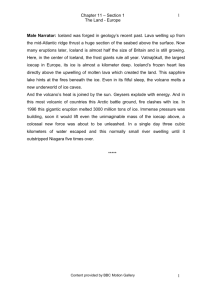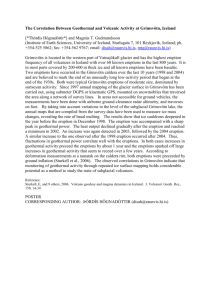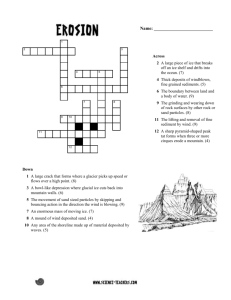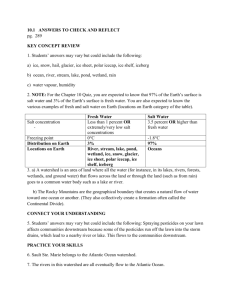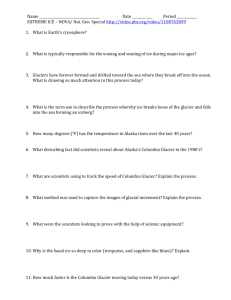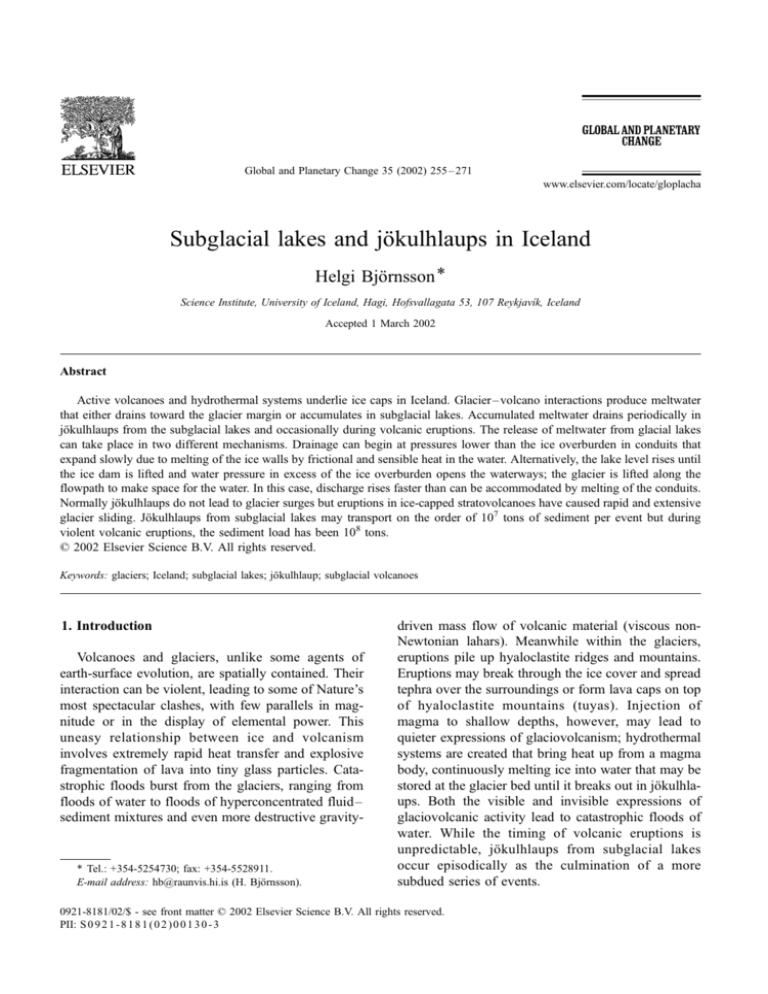
Global and Planetary Change 35 (2002) 255 – 271
www.elsevier.com/locate/gloplacha
Subglacial lakes and jökulhlaups in Iceland
Helgi Björnsson *
Science Institute, University of Iceland, Hagi, Hofsvallagata 53, 107 Reykjavı́k, Iceland
Accepted 1 March 2002
Abstract
Active volcanoes and hydrothermal systems underlie ice caps in Iceland. Glacier – volcano interactions produce meltwater
that either drains toward the glacier margin or accumulates in subglacial lakes. Accumulated meltwater drains periodically in
jökulhlaups from the subglacial lakes and occasionally during volcanic eruptions. The release of meltwater from glacial lakes
can take place in two different mechanisms. Drainage can begin at pressures lower than the ice overburden in conduits that
expand slowly due to melting of the ice walls by frictional and sensible heat in the water. Alternatively, the lake level rises until
the ice dam is lifted and water pressure in excess of the ice overburden opens the waterways; the glacier is lifted along the
flowpath to make space for the water. In this case, discharge rises faster than can be accommodated by melting of the conduits.
Normally jökulhlaups do not lead to glacier surges but eruptions in ice-capped stratovolcanoes have caused rapid and extensive
glacier sliding. Jökulhlaups from subglacial lakes may transport on the order of 107 tons of sediment per event but during
violent volcanic eruptions, the sediment load has been 108 tons.
D 2002 Elsevier Science B.V. All rights reserved.
Keywords: glaciers; Iceland; subglacial lakes; jökulhlaup; subglacial volcanoes
1. Introduction
Volcanoes and glaciers, unlike some agents of
earth-surface evolution, are spatially contained. Their
interaction can be violent, leading to some of Nature’s
most spectacular clashes, with few parallels in magnitude or in the display of elemental power. This
uneasy relationship between ice and volcanism
involves extremely rapid heat transfer and explosive
fragmentation of lava into tiny glass particles. Catastrophic floods burst from the glaciers, ranging from
floods of water to floods of hyperconcentrated fluid–
sediment mixtures and even more destructive gravity-
* Tel.: +354-5254730; fax: +354-5528911.
E-mail address: hb@raunvis.hi.is (H. Björnsson).
driven mass flow of volcanic material (viscous nonNewtonian lahars). Meanwhile within the glaciers,
eruptions pile up hyaloclastite ridges and mountains.
Eruptions may break through the ice cover and spread
tephra over the surroundings or form lava caps on top
of hyaloclastite mountains (tuyas). Injection of
magma to shallow depths, however, may lead to
quieter expressions of glaciovolcanism; hydrothermal
systems are created that bring heat up from a magma
body, continuously melting ice into water that may be
stored at the glacier bed until it breaks out in jökulhlaups. Both the visible and invisible expressions of
glaciovolcanic activity lead to catastrophic floods of
water. While the timing of volcanic eruptions is
unpredictable, jökulhlaups from subglacial lakes
occur episodically as the culmination of a more
subdued series of events.
0921-8181/02/$ - see front matter D 2002 Elsevier Science B.V. All rights reserved.
PII: S 0 9 2 1 - 8 1 8 1 ( 0 2 ) 0 0 1 3 0 - 3
256
H. Björnsson / Global and Planetary Change 35 (2002) 255–271
Iceland is a unique and valuable study site for
glaciovolcanic interactions. At present, 10% (11,200
km2) of Iceland is ice-covered and 60% of the ice
overlies the active volcanic zone (Fig. 1). During the
20th century, 15 subglacial volcanic eruptions (10
major and five minor events) took place, about onethird of all eruptions in Iceland during that century.
During the Pleistocene Era when Iceland was
entirely covered with ice, the Palagonite Formation,
characterised by hyaloclastite ridges, mounds and
tuyas, was formed across the entire country (Kjartansson, 1943; Mathews, 1947; Bemmelen and van
Rutten, 1955; Jakobsson, 1979; Jóhannesson et al.,
1990). Studies of the processes presently at work in
glaciated volcanic areas provide information about
the agents that shaped the landscape during the
Pleistocene Era. This applies to the heat exchange
between magma and the glacier, the dynamical
response of the glacier to subglacial eruptions, the
structure and growth sequence of hyaloclastite ridges
and tuyas formed by subglacial eruptions, and
jökulhlaups due to volcanic eruptions. Jökulhlaups,
both those draining meltwater stored in subglacial
lakes and meltwater produced during a volcanic
eruption, have significant landscaping potential: they
erode large canyons and transport and deposit enormous quantities of sediment and icebergs over vast
outwash plains and sandur deltas. Pleistocene glacial
river canyons may have been formed in such catastrophic floods from subglacial lakes. Jökulhlaups
have threatened human populations, farms and
hydroelectric power plants on glacier-fed rivers.
They have damaged cultivated and vegetation areas,
disrupted roads on the outwash plains and have even
generated flood waves in coastal waters. Knowledge
of the sources and behaviour of jökulhlaups is
essential for advanced warnings and civil defence
in Iceland. Monitored seismic activity announces
volcanic eruptions, and maps of bedrock and glacier
surface topography can be used to delineate jökulhlaup hazard zones (Björnsson and Einarsson, 1991).
Studies of glacier – volcano interactions on Earth may
further understanding of the impact of volcanism on
other planets such as Mars.
This paper describes glacier – volcano interactions
and jökulhlaups in Iceland with an emphasis on the
formation and geometry of subglacial lakes in hydrothermal areas and jökulhlaup drainage characteristics.
In the present paper, we only consider the drainage of
water in two ice caps, Vatnajökull and Mýrdalsjökull.
Fig. 1. Location map of Iceland showing ice caps, the volcanic zone (The Palagonite Formation) and the central volcanoes.
H. Björnsson / Global and Planetary Change 35 (2002) 255–271
2. Ice caps, volcanic centres and drainage basins
Subglacial topography of all the major ice caps in
Iceland has been mapped by radio echo sounding,
revealing bedrock elevations from 300 to 1800–
2000 m relative to sea level. The volcanic zone
underlies the four largest ice caps and the most active
volcanoes are located under the ice cap Mýrdalsjökull
(600 km2) and the western part of Vatnajökull (8100
km2), which is positioned over the centre of the
Icelandic mantle plume (Wolfe et al., 1997). No
eruptions have taken place in Hofsjökull (925 km2)
or Langjökull (925 km2) ice caps during the last
millennium.
Five volcanic systems have been identified under
the ice cap Vatnajökull (Fig. 1), each containing
central volcanoes and fissure swarms that stretch for
tens of kilometres (Björnsson, 1988; Jóhannesson et
al., 1990; Björnsson and Einarsson, 1991). The most
active are the Grı́msvötn and Bárdarbunga volcanic
systems, both of which have relief of up to 1000 m
and contain calderas 600 –700 m deep and 15– 20 km
in diameter. In Grı́msvötn, about 30 eruptions have
been reported over the last 400 years (Thorarinsson,
1974; Björnsson and Einarsson, 1991). More than 80
volcanic eruptions occurred during the last 800 years
in Vatnajökull (Larsen et al., 1998). Since the settlement of Iceland around 870 A.D., 20 volcanic eruptions have been traced to the Katla volcanic system in
Mýrdalsjökull ice cap (Larsen, 2000). This volcanic
system contains a 600– 750 m deep caldera that is
10 –15 km in diameter (Björnsson et al., 2000).
At several of the central volcanoes under Vatnajökull and Mýrdalsjökull hydrothermal activity
results from the interaction of water with magmatic
intrusions at shallow depths in the crust (Thorarinsson, 1974; Björnsson, 1988; Björnsson et al., 2000,
2001a). Ice is continuously melted at the glacier bed
creating permanent depressions in the glacier surface
that reveal this hydrothermal activity. The meltwater,
however, may be trapped in a lake at the bed due to
relatively low basal fluid potential under the depression. High ice overburden pressure at the rim around
the depression seals the lake. The best-known examples of such subglacial lakes are Grı́msvötn in the
interior of Vatnajökull and the Skaftá cauldrons (Fig.
1). Smaller lakes of this kind are located at Pálsfjall
and Kverkfjöll. The current hydrothermal activity in
257
Mýrdalsjökull is concentrated just inside the caldera
rims, where faults allow rapid vertical transport of
hydrothermal fluid.
2.1. Drainage basins
On the basis of the glacier surface and bedrock
maps, the ice and water drainage basins on all the
major ice caps in Iceland have been delineated and the
location and geometry of subglacial lakes identified
(Björnsson, 1982, 1986, 1988; Björnsson et al., 2000).
The glacierized portion of catchment basins for the
major glacial rivers has been drawn as a continuation
of the watershed outside the glacier. In principle, the
watershed at the glacier base is situated along ridge
crests in the fluid potential
/b ¼ qw gzb þ pw ;
ð1Þ
which is the sum of terms expressing the gravitational
potential and the water pressure, pw. The symbol
qw = 1000 kg m 3 represents the density of water,
g = 9.81 m s 2 is the acceleration due to gravity and
zb is the elevation of the glacier substrate relative to
sea level. Water in an isotropic basal layer would flow
perpendicularly to lines of equal potential. The basal
water pressure is assumed to be static,
pw ¼ kpi ;
ð2Þ
where pi = qigH is the ice overburden pressure, k is a
constant, qi = 916 kg m 3 is the density of ice,
H = zs zb is the thickness of the glacier and zs is
the elevation of the ice surface relative to the sea level
(Shreve, 1972). In our experience, k is close to one
(Björnsson, 1982, 1988) and thus the gradient driving
the water is
j/b ¼ ðqw qi Þgjzb þ gqi jzs :
ð3Þ
This expression predicts that the glacier surface
slope is about 10 times more effective than the bed
slope in controlling basal water flow. This static
approximation of water pressure ( pw c pi) is plausible at low values of discharge and is therefore useful
for delineating water divides.
Vatnajökull and Mýrdalsjökull have been divided
into 15 and three major drainage basins, respectively
(Fig. 2). Six basins in Vatnajökull, where water accu-
258
H. Björnsson / Global and Planetary Change 35 (2002) 255–271
Fig. 2. Drainage basins, and location of subglacial geothermal systems. (a) Vatnajökull: The internal drainage basins of Grı́msvötn and Skaftá
Cauldrons drain in jökulhlaups. (b) Mýrdalsjökull: Cauldrons produced by subglacial geothermal activity.
mulates into subglacial lakes, are not connected to the
glacier margin and water may accumulate under 12
small ice cauldrons in Mýrdalsjökull. During volcanic
eruptions, depressions are created in the glacier surface
above the eruption site and the location of the watersheds may change. Nevertheless, if our model of a
static fluid potential applies at the beginning of an
eruption, we consider it likely that meltwater from the
H. Björnsson / Global and Planetary Change 35 (2002) 255–271
259
eruption site will continue to drain through existing
conduits.
meet the condition of zero gradient in the fluid
potential.
2.2. Subglacial lakes
2.3. Anatomy of a jökulhlaup
Subglacial lakes can be situated where there is no
gradient in the fluid potential that drives water along
the glacier bed. The condition j/b = 0 has been used
to define the location and geometry of subglacial
lakes. Hence
Subglacial lakes beneath ice-surface depressions
drain periodically in outburst floods. A subglacial lake
gradually expands as water flows toward the depression, the basal water pressure increases and the overlying glacier is lifted. Before the surface depression is
completely flattened, the hydraulic seal is broken and
water begins draining out of the lake at the base under
the ice dam. The water escapes through narrow passages at the ice-bed interface but the pressure head
maintained by a voluminous lake drops slowly. Although the pressure of the ice squeezes the tunnel
draining water from the lake, water flow is primarily
controlled by tunnel enlargement. In most cases, tunnel
enlargement can be explained as melting of the ice
walls by frictional heat generated by the flowing water
and thermal energy stored in the lake (Nye, 1976;
Clarke, 1982; Björnsson, 1992). The lake may become
sealed again before it is empty and accumulation of
water begins until a new jökulhlaup occurs.
Nye (1976) presented a general theory of flow in
water-filled tunnels based on the principles of mass
continuity, energy conservation, heat transfer and
water discharge for a given fluid potential gradient.
He derived an analytical solution predicting discharge
jzb ¼ ðqi =ðqw qi ÞÞjzs ;
ð4Þ
describes a relationship between the slope of the ice/
water boundary of the lake and the upper glacier
surface. The shape of the lake results from an equilibrium of vertical forces as the overlying glacier floats
in static equilibrium. The roof of the subglacial lake
slopes approximately 10 times more steeply than the
glacier surface, and in the opposite direction (Fig. 3).
In Icelandic ice caps, several lakes are known to
exist beneath surface depressions created above
hydrothermal systems. The lakes rise as a dome above
the bed, even capping mountains (Björnsson, 1975).
Theory combined with topographic maps suggests
that the slopes of glacier-bed depressions beneath
ice caps in Iceland are not sufficient to accumulate
water without accompanying depressions in the glacier surface. However, there could be lakes, not
treated here, with equal in- and outflow that do not
Fig. 3. Schematic drawing of two main types of subglacial lakes; (a) a stable lake, (b) an unstable lake that drains in jökulhlaups.
260
H. Björnsson / Global and Planetary Change 35 (2002) 255–271
Q to rise asymptotically with time as Q(t) = k(1/t)4 if
the overburden closure is neglected and the expansion
of the ice tunnel is solely due to the instantaneous
transfer of frictional heat from the flowing water to the
ice walls (loss of potential energy). Under the assumption of instantaneous heat transfer, water would
emerge at the river outlet at the melting point, as is
generally observed in jökulhlaups in Iceland, whereas
the heat transfer equation would predict higher temperatures.
Occasionally, the discharge hydrograph for jökulhlaups increases faster than can be explained by the
expansion of conduits by melting (Björnsson, 1997).
The water pressure exceeds the ice overburden and the
glacier is lifted to make space for the water (Björnsson, 1992, 1997). This event cannot be explained by
the classical theory of jökulhlaups. Jóhannesson
(2002) has described these floods as characterized
by a propagation of a subglacial pressure wave. A
preliminary model study suggests that the idea of a
sheet flood preceding conduit drainage is plausible
(Björnsson et al., 2001b).
3. Subglacial lakes, volcanic eruptions and
jökulhlaups in Vatnajökull
Six subglacial lakes have been discovered in Vatnajökull (Fig. 2). For two of these, we will describe
their geometry and growth, and the characteristics of
their jökulhlaups.
3.1. Grı́msvötn: geometry and drainage of ice and
water
Grı́msvötn, the largest subglacial lake in Iceland, is
located in the western part of Vatnajökull (Fig. 4a,
Table 1). The glacier covers a hydrothermal area and a
10-km wide and 300-m deep depression has been
created in the ice surface (Björnsson, 1974, 1988).
The extent of the subglacial lake is identified by the
flat ice shelf floating on the lake and the abrupt
change in surface slope at the margins. Subglacial
topography is known from radio echo-soundings and
seismic profiling (Björnsson, 1988; Guðmundsson,
1989, 1992). The lake is situated within the caldera
floor of the Grı́msvötn volcano and to the south and
west the caldera walls (Mt. Grı́msfjall) protrude
through the glacier surface and confine the lake, but
the lake can expand to the north and northeast as the
water level rises. The lowest breach of the caldera
rims is 1150 m but due to the glacier surface depression the lake level at the slopes of Mt. Grı́msfjall can
rise more than 300 m higher. The ice-shelf thickness
has been measured regularly by radio echo-soundings
and computed from measured surface elevations,
assuming the shelf is floating in hydrostatic equilibrium. The ice shelf gradually thickened from 150 m
in the 1950s to 230 – 260 m in the 1980s due to
reduced melting by the hydrothermal system (Björnsson and Guðmundsson, 1993). Hence, the extent and
volume of the subglacial lake has gradually been
reduced. The total volume of water drained out of
Grı́msvötn in jökulhlaups has been derived using
known variations in lake level during jökulhlaups,
the thickness of the floating ice cover on the lake and
the bedrock topography in the Grı́msvötn area
(Björnsson, 1988, 1992).
In recent years the lake level has risen 10 –15 m
year 1 and a jökulhlaup occurs when it rises 80 –110
m and reaches a particular threshold (Fig. 5). The
onset of lake drainage is marked by ice-quakes and
subsidence of the lake level, and the arrival time of
lake water to the glacier margin is identified by a
sulphurous odour in the glacial river. Jökulhlaups
from Grı́msvötn flow beneath Skeiðarárjökull a distance of 50 km to the terminus at Skeiðarársandur.
The flowpath reaches a depth of 200 m below sea
level before it emerges on the outwash plain. In the
most violent jökulhlaups from Grı́msvötn, the entire
outwash-plain, Skeidarársandur, has been flooded.
Jökulhlaups from Grı́msvötn have occurred at 1– to
10 –year intervals, with peak discharges of 600 to 4–
5 104 m3 s 1 at the glacier margin, a duration of 2
days to 4 weeks and a total volume of 0.5– 4.0 km3
(Table 2; Björnsson and Guðmundsson, 1993;
Guðmundsson et al., 1995; Björnsson, 1997; Snorrason et al., 1997). In general, the frequency of jökulhlaups and the volume of water released depends upon
the thickness of the ice barrier (Thorarinsson, 1974).
The typical threshold lake-level for triggering a
jökulhlaup is 60– 70 m lower than required for simple
flotation of the ice dam (Björnsson, 1988, 1992). This
suggests that some process other than lifting finally
breaks the seal and permits the water to enter conduits
beneath the ice dam, resulting in a jökulhlaup. Jökulh-
H. Björnsson / Global and Planetary Change 35 (2002) 255–271
261
Fig. 4. (a) An oblique aerial photograph of Grı́msvötn after the 10-km-wide and 270-m-thick ice cover had subsided 175 m during the 1996
jökulhlaup. View from the NNW toward the 400-m-high Mt. Grı́msfjall (the southern caldera rim). (b) The 150-m-deep and 3-km-wide eastern
Skaftá cauldron, just after a jökulhlau in January 1982. The crevasse trending from the upper left of the cauldron suggests lifting of the ice dam.
Further cauldrons are seen in the background. (c) The river Skeiðará flowing down the Skeidarársandur outwash plain to the coast. Dykes
control the river on the left hand side. The bridge across the river is 900 m long. (d) The 300-m-deep Jökulsárgljúfur canyon, north of
Vatnajökull, eroded and carved during prehistoric jökulhlaups.
262
H. Björnsson / Global and Planetary Change 35 (2002) 255–271
Table 1
Data on two subglacial lakes in Vatnajökull (Björnsson, 1988; Björnsson and Guðmundsson, 1993)
Source
Catchment
basin
(km2)
Lake area
(km2)
Ice cover
thickness
(m)
Geothermal
output
(MW)
Basal melting
rate
(m3 s 1)
Meltwater
accumulation
rate
(km 3 year 1)
Lake level
rising rate
(m year 1)
Lake level
fluctuations
between
jökulhlaups (m)
Grı́msvötn
E-Skaftá
cauldron
160
40
5 – 40
<5
150 – 270
400
2 103 – 4 103
800
6 – 12
2.5
0.2 – 0.5
0.1
10 – 15
25
80 – 175
100
The basal melting rate may be underestimated as it is calculated from the drained meltwater during jökulhlaups and does not include meltwater
drained into groundwater.
laups from Grı́msvötn occur at any time of the year so
sudden changes in subglacial drainage due to surface
melting do not, in general, trigger jökulhlaups. A few
jökulhlaups have occurred from Grı́msvötn at lake
levels far below the usual threshold. These premature
jökulhlaups may have been triggered by the opening
of waterways from the lake along the northeastern
slopes of Grı́msfjall (higher than the lowest crest at
the caldera rim) facilitated by increased localized
melting due to hydrothermal or volcanic activity.
Jökulhlaups from Grı́msvötn terminate abruptly,
often within a few hours, once the water level has
dropped about 100 m. This occurs before the lake is
empty, when the ice overburden pressure at the rock
rim exceeds the hydrostatic water pressure by 10 –15
bars. The water level in the lake does not drop to 1150
m, the level of the subglacial caldera ridge.
3.2. Characterisitics of jökulhlaups from Grı́msvötn
Typically jökulhlaups from Grı́msvötn increases
approximately exponentially to the peak, and falls
more rapidly afterward (Fig. 6). The duration of large
floods tends to be shorter than that of small floods. The
smaller jökulhlaups reach their peak in 2– 3 weeks and
terminate about 1 week later. This discharge pattern
can be explained by enlargement of a single basal ice
tunnel due to melting by frictional heat generated in
the flowing water. The drainage affects glacier sliding
only over small localized areas. All such outburst
floods drain through one main ice tunnel, which feeds
Skeiðará. If discharge exceeds about 3000 m3 s 1,
water starts to drain from other, smaller tunnels at the
central part of the terminus, collecting into the river
Gı́gja. In the most voluminous floods, 10 – 15 highcapacity ice tunnels develop (Björnsson, 1998). The
rapid injection of water creates high water pressures, as
evidenced by water forced up to the glacier surface
through crevasses that formed in 300-m-thick ice.
To date, modelling based on the theory of Nye
(1976) and Clarke (1982) has succeeded in simulating
the increasing discharge of several jökulhlaups from
Grı́msvötn but fails to adequately represent the sharp
transition from increasing to decreasing discharge
Fig. 5. The lake level of Grı́msvötn 1930 – 2000. The lake level ascends until a jökulhlaup takes place. In 1996 the lake rose to the level required
for floating of the ice dam.
H. Björnsson / Global and Planetary Change 35 (2002) 255–271
263
Table 2
Data on typical jökulhlaups from subglacial lakes in Vatnajökull (Björnsson, 1988, 1992)
Source
Subglacial
flowpath (km)
Drainage
interval (year)
Peak discharge
(m3 s 1)
Duration
(days)
Volume
(km3)
Sediment load
(106 ton)
Grı́msvötn
E-Skaftá cauldron
50
40
1 – 10
3
0.6 – 50 103
0.2 – 1.5 103
2 – 30
2 – 15
0.5 – 4
0.1 – 0.3
30 – 150
30
(Björnsson, 1992). A cylindrical tunnel apparently
cannot describe the fast closure of the conduit. Nye’s
(1976) prediction that the discharge Q rises asymptotically with time as Q=(1/t)4 successfully described the
rising limb of the jökulhlaup from Grı́msvötn in 1972.
Spring and Hutter (1981) applied the general equations, which include thermal energy stored in the lake
to simulate the 1976 hydrograph and concluded the
lake water would have been 4 jC. The lake temperature, however, was measured close to the melting
point (Björnsson, 1992). This supports the observation that the actual heat transfer by flowing water
during jökulhlaups is more effective than accounted
for by the empirical heat transfer equation described
by Nye (1976) and Spring and Hutter (1981). Occasionally, jökulhlaup discharge has increased at a rate
suggesting that thermal energy stored in the lake
contributed to tunnel expansion. The rise of the
jökulhlaup in 1934 can be simulated by lake water
of 1 jC, and in 1938 by water of 4 jC when a peak of
Fig. 6. (a) Typical hydrographs of jökulhlaups from Grı́msvötn (1934, 1938, 1954, 1972, 1976, 1982, 1986 and 1996). (b) Left: typical shape of
a hydrograph when a single basal ice tunnel enlarges due to melting. Right: Rapidly rising hydrograph that is not explained by the classical
theory of jökulhlaups (typical for jökulhlaups from the Skaftá cauldrons).
264
H. Björnsson / Global and Planetary Change 35 (2002) 255–271
Fig. 7. Discharge hydrograph of the 1996 jökulhlaup from
Grı́msvötn, the cumulative volume of water drained and the
subsidence of the lake level (measured by precision barometric
altimetry).
3 105 m3 s 1 was reached in 4 days (Fig. 6). Lake
temperature values should not be taken seriously,
however, as the heat transfer theory is questionable.
3.3. Extraordinary jökulhlaups from Grı́msvötn
The jökulhlaup from Grı́msvötn in November 1996
was of an extraordinary type, draining so rapidly that
melting alone could not have expanded the conduits
(Fig. 7). For the first time in the observational history
of Grı́msvötn, the ice dam was floated off the bed
(Fig. 8). Downstream from the dam, water pressure
exceeded the ice overburden and the glacier was lifted
off the bed along the water flowpath (Björnsson,
1997; Roberts et al., 2000). Crevasses were observed
along the main flowpath and icebergs were broken off
the margin and spread over Skeidarársandur outwash
plain. As the first jökulhlaup of this kind to take place
after scientific observations began, it has provided
new insight into jökulhlaup hydrology. Similar
jökulhlaups may have occurred before, although
descriptions do not provide unquestionable evidence
for as rapid a rise in discharge (e.g. in 1861 and 1892;
Thorarinsson, 1974; Björnsson, 1988).
The 1996 jökulhlaup was preceded and indirectly
triggered by the Gjálp eruption, which took place
inside the drainage basin of Grı́msvötn (Figs. 1, 9
and 10). Meltwater was accumulated for a month until
it drained in the catastrophic jökulhlaup. The eruption
broke through the ice cover at one place after 30 hours
of eruption, but continued subglacially for 2 weeks on
a 6-km-long fissure. Melting by the eruption was
measured both from the volume of the surface depressions above the eruptive fissure, and from the volume
of meltwater accumulated in Grı́msvötn (Guðmundsson et al., 1997; Einarsson et al., 1997). During the
first 4 days meltwater was produced at a rate of 5000
m3 s 1 and the heat output at the peak of the eruption
was 1012 W (more than 100 times all the power
stations producing electricity in Iceland at that time).
The high rate of melting can only be due to fragmentation of the lava into glass (hyaloclastites) and rapid
cooling of the fragments by quenching. The total
volume of ice melted during the first 6 weeks after
the beginning of the eruption was 4.0 km3, equivalent
Fig. 8. A cross-section from Grı́msvötn to Skeiðarársandur along the flowpath of the jökulhlaup in 1996. Subglacial hydraulic conditions at the
beginning of the 1996 jökulhlaup: Pi/(qwg) is the ice overburden pressure in metres of hydraulic head; Pl/(qwg) is the hydraulic head maintained
by the lake. The ice dam was floated at the onset of the 1996 jökulhlaup.
H. Björnsson / Global and Planetary Change 35 (2002) 255–271
265
Fig. 9. (a) An oblique aerial photo of the 6-km-long, 2-km-wide and 100-m-deep depression formed above the flowpath of the 1996 jökulhlaup
across the ice dam of Grı́msvötn. (b) The margin of Skeiðarárjökull during the jökulhlap of 1996. The flood water emerged from the base
through crevasses 200 m higher than the margin.
to 1.1 1012 kg of magma cooling from 1000 to 0 jC
if all the heat were used for melting. After 1 year
(January 1998), the melted volume was 4.7 km3 (Fig.
10).
The meltwater accumulated in the Grı́msvötn
subglacial lake for a month until it drained in a
catastrophic jökulhlaup on November 4 – 7 1996, in
which 3.2 km3 of water drained from the lake within
a period of 40 hours. On November 4, the lake had
risen to the level required for flotation of the ice
dam, 1510 m, and ice-quakes marked the onset of
lake drainage. About 10.5 hours later, water emerged
from the margin of Skeiðarárjökull as a flood wave
inundating Skeiðarársandur (at 100 m elevation), in
the most rapid jökulhlaup ever recorded from Grı́msvötn (Fig. 7). The discharge out of the lake during
266
H. Björnsson / Global and Planetary Change 35 (2002) 255–271
Fig. 10. Photos of the Gjálp eruption in October and the Grı́msvötn jökulhlaup in November 1996. (a) A volcanic eruption through 500 – 700 m
thick glacier. (b) Icebergs spread over the outwash plain Skeiðarársandur during the jökulhlaup. (c) The plume of suspended sediment from the
Skeidará jökulhlaup 1996 off the southern coast of Iceland. The coastal line moved seaward by about 900 m.
this jökulhlaup was derived directly from lake level
observations and the known lake hypsometry. Discharge increased linearly with time and reached a
peak value of 4 104 m3 s 1 in 16 hours and
dropped to zero 27 hours later. The total volume
of water released from the glacier was estimated at
3.2 km3. During the drainage the lake surface subsided by 175 m (Fig. 5), and the floating ice cover
was reduced from 40 to less than 5 km2. While the
discharge hydrograph for the lake was derived, the
shape of the hydrograph for the outburst from
Skeiðarárjökull is unknown and likely to be different
since the flood was not drained through a single
subglacial conduit. Four points on the hydrograph,
two on the rising limb and two during the recession
were estimated but their accuracy is uncertain (Snorrason et al., 1997; Russel et al., 1999).
During the lake drainage, a 6-km-long, 1-km-wide
and 100-m-deep depression was created by collapse of
the jökulhlap flowpath across the ice dam. The volume
of the depression was 0.3 km3. Assuming that all of the
thermal energy in the lake was used in the formation of
the depression, we calculate the average temperature
of the 3.2 km3 of water released to be 8 jC. In addition
to this, we calculate that 0.1 km3 of water was
produced by frictional melting during the descent of
the water from Grı́msvötn to Skeiðarársandur.
When floodwater started to drain from the glacier
margin a volume of 0.6 km3 of water had accumulated under the glacier (Fig. 7). Melting enlargement
H. Björnsson / Global and Planetary Change 35 (2002) 255–271
of the conduit by the frictional heat of the flowing
water can only account for a portion (0.01 km3) of
the required conduit volume. Hence, lifting of the ice
by water pressure in excess of the overburden took
place during the beginning of the flood, prior to
conduit formation. Longitudinal crevasses were
observed above the entire flowpath. Approaching
the glacier terminus, basal water burst out on the
glacier surface through several hundred metres of
ice. Icebergs were broken off the margin and spread
over the outwash plain.
267
time of the peak discharge, only 25% of the flood
volume has drained out of the lake. The slow
recession after the peak suggests that these floods
do not drain through a single tunnel but spread out
beneath the glacier and later slowly collect into the
river outlet.
3.5. Jökulhlaups in Vatnajökull triggered directly by
volcanic eruptions
Jökulhlaups triggered by volcanic eruptions can be
traced to volcanic systems with the aid of maps of the
subglacial topography (Björnsson and Einarsson,
1991) (Table 3). Most jökulhlaups from Vatnajökull
have drained southward to Skeiðarársandur or northward to the river Jökulsá á Fjöllum (Thorarinsson,
1974; Björnsson, 1988; Björnsson and Einarsson,
1991). Major jökulhlaups occurred during two historical eruptions in the stratovolcano Öræfajökull (Fig.
2).
In general the volume of meltwater produced
during subglacial eruptions is higher the longer the
eruption remains entirely subglacial; hence, it tends to
be higher the thicker the glacier and the longer
melting of ice can be compensated by fast inflow of
surrounding ice. This applies as long as the original
ice thickness does not produce such high confining
pressure that pillow lava is formed and the heat
transfer is reduced. Two fissure eruptions under
500– 700 m thick ice north of Grı́msvötn, in 1938
and 1996, produced 2.7 km3 (0.3 – 0.5 km3 of hylaoclastite) and 4.0 km3 of meltwater, respectively
(Björnsson, 1988; Guðmundsson and Björnsson,
1991; Guðmundsson et al., 1997). In contrast, eruptions inside lake Grı́msvötn typically break through a
150– 200 m thick ice shelf in 10 –20 min, forming an
opening 0.5 km in diameter and only melting small
quantities of ice (about 0.1 km3, Guðmundsson and
Björnsson, 1991). Eruptions within Grı́msvötn do not
3.4. The Skatfá ice cauldrons and jökulhlaups
The two Skaftá cauldrons are situated over geothermal systems, 10 – 15 km to the northwest of
Grı́msvötn (Figs. 2 and 4b). Since 1955, at least
30 jökulhlaups have drained from these cauldrons to
the river Skaftá. The period between these drainage
events is about 2 – 3 years. Jökulhlaup discharge
from the eastern Skaftá Couldron typically rises
rapidly and recedes slowly (Björnsson, 1977). The
form of the hydrograph is a mirror image of the
typical Grı́msvötn hydrograph (Fig. 6). The peak
discharge from the eastern cauldron is 1000 – 1500
m3 s 1 and is reached in 1 –3 days. These jökulhlaups recede slowly in 1 – 2 weeks and the total
volume of water expelled is 200 – 350 106 m3
(Table 2). Theoretical simulations fail entirely to
describe these hydrographs (Björnsson, 1992). The
steep rise in discharge can be simulated with lake
water well above the melting point (10 – 20 jC) but
these values are derived from a flawed theory. Water
at the melting point drains from the glacier. The
rapid Skaftá jökulhlaups fall in the category that are
not explained by the classical theory of jökulhlaups.
Crevasses observed across the ice dam of the eastern
cauldron after jökulhlaups suggest that the jökulhlaups start with flotation of the glacier (Fig. 4b). At the
Table 3
Data on typical jökulhlaups triggered by volcanic eruptions (see references in Sections 3.5 and 4)
Vatnajökull
Mýrdalsjökull
Period
(year)
Subglacial
flowpath (km)
Peak discharge
(m3 s 1)
Duration
(days)
Volume of
meltwater
(km3)
Sediment
load
(106 ton)
Peak thermal
output (W)
Total thermal
energy (J)
5 – 30
40 – 80
50
20
5 103 – 1 106
1 105 – 3 105
2 – 30
2 – 10
3–5
1–8
100 – 300
2000
1.7 1012
3 1013 – 1014
1018
1018 – 1019
Thermal output of subglacial volcanic eruptions derived from production of meltwater. (Gjálp 1996, Katla 1918).
268
H. Björnsson / Global and Planetary Change 35 (2002) 255–271
cause accumulation of water and increased pressure
head, because melting of a floating ice cover does not
add any mass to the system—hence they do not
trigger jökulhlaups. The volume of volcanic material
injected to the lake is negligible. However, jökulhlaups may trigger eruptions by the pressure release on
top of the volcano subsequent to the lake level falling
about 80 –100 m (Thorarinsson, 1974; Guðmundsson
et al., 1995). Seismic records suggest that this mechanism may have triggered several small but invisible
eruptions under the Skaftá cauldrons after 1985 (Páll
Einarsson, personal communication). Pressure release
during a jökulhlaup may also cause explosive boiling
in a subglacial hydrothermal area.
The largest and most catastrophic jökulhlaups in
Iceland may be caused by eruptions in the voluminous,
ice-filled calderas of Bárðarbunga and Kverkfjöll in
northern Vatnajökull (see Björnsson, 1988; Björnsson
and Einarsson, 1991). These calderas may be the source
of prehistoric jökulhlaups in Jökulsá á Fjöllum, with
estimated peak discharges of up to 4 105 to 1 106
m3 s 1 (Tómasson, 1973; Knudsen and Russell, 2002)
that swept down Jökulsá á Fjöllum and carved a scablands and deep canyons (Jökulsárgljúfur).
Jökulhlaups during eruptions in steep ice and snow
covered stratovolcanoes are swift and dangerous and
may become lahars and debris-laden floods. The first
contemporary description of a jökulhlaup during a
volcanic eruption in Iceland dates from the 1362
eruption of the ice capped stratovolcano Öræfajökull
(Thorarinsson, 1958). The flood was over in less than
1 day and the peak may have been greater than 105 m3
s 1 (Thorarinsson, 1958, p. 36). The meltwater originated in the 500 m deep caldera summit area at 2000 m
elevation and drained beneath the outlet glaciers. Sediment, hummocks (2– 4 m high) and dead ice were
spread over the lowland and into the sea, and a plain
was formed where there had been thirty fathoms water
(Skálholt Annal). Several farmsteads were washed
away. A contemporary record described ‘‘several
floods of water that gushed out, the last of which
was the greatest. When these floods were over the
glacier itself slid forwards over the plane ground, just
like melted metal poured out of a crucible. . .. The
water now rushed down on the earth side without
intermission, and destroyed what little of the pasture
grounds remained. . .. Things now assumed quite a
different appearance. The glacier itself burst and many
icebergs were run down quite to the sea, but the
thickest remained on the plain at a short distance from
the foot of the mountain. . . we could only proceed with
the utmost danger, as there was no other way except
between the ice-mountain and the glacier that had slid
forwards over the plain, where the water was so hot
that the horses almost got unmanageable’’ (Report by
Rev. Jón Thorláksson, cited by Henderson, 1818;
Thorarinsson, 1958, p. 31). Obviously, the water conduits could not adjust to this rapid injection of meltwater, and increased water pressure reduced basal
friction and facilitated sliding. A less devastating
eruption took place in 1727 A.D. (Thorarinsson,
1958). The sediment and icebergs that were transported down to the lowland were later named glaciers
and these place names are still used centuries after all
the ice has melted away.
Similar rapid floods carrying volcanic material were
produced from Eyjafjallajökull (in 1612 and 1821–
1823), and during the eruption at Mt. Hekla in 1845,
1947 (Kjartansson, 1951), 1970 and 1981 in the river
Rangá.
4. Subglacial lakes, volcanic eruptions and
jökulhlaups in Mýrdalsjökull
Mýrdalsjökull can be divided into three major catchment basins that supply water to the outwash plains
Mýrdalssandur, Sólheimasandur and Markarfljótsaurar, respectively (Fig. 2b). The glacier surface has
12 small depressions that have been created by subglacial hydrothermal activity. These ice cauldrons are
typically 20 –50 m deep and 500 –1000 m wide. A
persistent hydrogen sulphide odour from Jökulsá á
Sólheimasandi indicates that meltwater is drained continuously. Meltwater accumulates beneath some of the
cauldrons and frequently drains in small jökulhlaups
(Rist, 1967; Björnsson et al., 2000; Russel et al., 2000).
Katla eruptions rapidly melt large volumes of ice,
triggering enormous jökulhlaups and breaking off large
blocks of ice from the glacier margin. Meltwater may
also drain out supraglacially through crevasses and
moulins. During the jökulhlaups, a mixture of water,
ice, volcanic products and sediment, surges over the
outwash plain. Water-transported volcanic debris has
been estimated from 0.7 to 1.6 km3 or on the order of
2 109 tons per event (Tómasson, 1996; Larsen,
H. Björnsson / Global and Planetary Change 35 (2002) 255–271
2000). During the most violent jökulhlaups such large
quantities of icebergs and sediment were clustered
together that some places on the outwash plain were
named for glaciers. The peak discharge of 1 –3 105
m3 s 1 is reached in a few hours, and total volumes of
1 –8 km3 draining over 3 –5 days have been suggested
(Table 3; Thorarinsson, 1957, 1974; Tómasson, 1996;
Larsen, 2000). The rate of increase of discharge and
peak discharges are an order of magnitude higher than
for any known jökulhlaup from subglacial lakes. These
jökulhlaups, along with heavy fallout of tephra, make
Mýrdalsjökull the most hazardous volcano in Iceland.
Fascinatingly, the Katla eruptions break through an
ice cover of 400 m in 1 or 2 h. Nonetheless, the
melting rate during the most violent Katla eruptions is
an order of magnitude higher than during the Gjálp
eruption in 1996 (Table 3, Guðmundsson et al., 1997).
The heat flux of Katla may be overestimated because
the peak jökulhlaup discharges are higher than the
production rate of meltwater. Water may be stored at
the eruption site, either at the beginning of the
eruption because the conduits cannot accommodate
the flow, or over a longer period due to increased heat
flux from the volcano and subsequent formation of a
depression in the surface. Eruptions of magma into
such a subglacial water body would make possible
rapid heat transfer during the eruption and ensure
rapid cooling by fragmentation of the lava into glass.
Mýrdalssandur and the adjacent Sólheimasandur
and Skógasandur have to a large extent been built in
floods caused by volcanic eruptions of the Katla
volcano. During 18 of the 20 documented eruptions
the associated jökulhlaups flowed southeast down to
the Mýrdalssandur outwash plain, but in two cases
jökulhlaups flowed southwest to the Sólheimasandur
outwash plain. During the last eruption in 1918, the
jökulhlaup moved the coastline seawards by 3 km
(Tómasson, 1996), and the coastline now lies 2.2 – 2.5
km further south than it did in 1660. Marine sediments
found several hundred kilometres south of Iceland,
contain debris transported from the eruption sites
(Guðrún Helgadóttir and Haraldur Sigurdsson, personal communication). The most rapid jökulhlaups have
produced flood waves in coastal waters. Jökulhlaups
from the northern part of Mýrdalsjökull have eroded
canyons in Markarfljót River (Sigurðsson, 1988). The
most recent jökulhlaup taking that route was 1600 years
ago (Haraldsson, 1981; Sigurðsson, 1988).
269
5. Conclusions
Of our main findings of the glacier volcano interactions in Iceland, we can summarize the following
conclusions.
Volcanic eruptions to the glacier bed are the most
violent expressions of glaciovolcanism, rapidly melting ice and producing hazardous floods outside the
glacier. Subglacial hydrothermal systems are quieter
expressions, generated by interaction of glacial meltwater with magma intrusions in the Earth’s crust. The
hydrothermal activity continuously melts ice at the
glacier bed, creating a depression in the glacier surface. The meltwater drains either continuously to the
glacier margin or accumulates in subglacial lakes that
are situated beneath the glacier surface depressions.
Some of the lakes are located in caldera depressions
but they rise as a dome above the caldera rims due to
the relatively low fluid pressure under the glacier
depression. The release of water from the subglacial
lakes can take place by two different conduit initiation
mechanisms. Drainage begins either through conduits
at pressures lower than the ice overburden at the ice
dam (in Grı́msvötn, typically 6 –7 bars lower) or the
lake level rises until the ice dam is floated. The
subsequent drainage from the lake can take place by
two different modes. The conduits may enlarge over
days or weeks due to melting of the ice walls by
frictional heat in the flowing water and stored lake
heat. This is typical for the jökulhlaups initiated at
lake levels lower than that required for flotation.
These processes have been explained by classical
jökulhlaup theories. Alternatively, the discharge rises
faster than can be accommodated by melting of the
conduits and the glacier is lifted along the flowpath to
make space for the water. A preliminary modeling
study suggests that the idea of a sheet flood preceding
conduit drainage is plausible.
During rapidly rising jökulhlaups, water may drain
through braided watercourses at high pressures. However, these passageways quickly develop into highcapacity ice tunnels, and jökulhlaups are not known to
have led to surges of glaciers. Icebergs may be broken
off the glacier margins and transported by water over
the river courses. During eruptions in steep ice-capped
stratovolcanoes (like Öræfajökull) distributed drainage of meltwater has led to sliding of the glacier down
to the lowland.
270
H. Björnsson / Global and Planetary Change 35 (2002) 255–271
Processes and products of glacier volcano interaction are displayed on a broad rage of dimensions.
Hydrothermal systems affect drainage areas of 5 –200
km2 and the area of the subglacial lakes is from 1 to
40 km2 in area. The production rate of basal glacial
meltwater spans over four to five orders of magnitude, from 2 to 6 m3 s 1 in hydrothermal systems to
5 103 to 105 m3 s 1 in volcanic eruptions (requiring a heat flux of 103 – 108 MW). The lakes vary in
volume by three orders of magnitude (lakes beneath
cauldrons of 2 109 to 4 1012 m3 in Grı́msvötn).
The lakes drain periodically with an interval of 1 –10
years. The duration of the jökulhlaups may be from
2 – 3 days to 2 – 3 weeks. The peak discharge in
jökulhlaups can be from 200 to 106 m3 s 1. Ordinary
jökulhlaups from subglacial lakes may transport of
the order of 107 tons of sediment but during the most
violent volcanic eruptions the sediment load has been
108 tons.
Acknowledgements
The work has been supported by the Public Roads
Administration, The National Power Company of
Iceland, and by the European Union (Framework VEnergy, Environment and Sustainable Development,
contract EGV1-2000-00512, GLACIORISK). Finnur
Pálsson helped me drawing the figures. I am indebted
to Gwenn E. Flowers for constructive comments on
the manuscript.
References
Bemmelen, R.W., van Rutten, M.G., 1955. Tablemountains of
Northern Iceland. E.J. Brill, Leiden, 217 pp.
Björnsson, H., 1974. Explanation of jökulhlaups from Grı́msvötn,
Vatnajökull, Iceland. Jökull 24, 1 – 26.
Björnsson, H., 1975. Subglacial water reservoirs, jökulhlaups and
volcanic eruptions. Jökull 25, 1 – 14.
Björnsson, H., 1977. The cause of jökulhlaups in the Skaftá river,
Vatnajökull. Jökull 27, 71 – 78.
Björnsson, H., 1982. Drainage basins on Vatnajökull mapped by
radio echo soundings. Nordic Hydrology, 213 – 232.
Björnsson, H., 1986. Surface and bedrock topography of ice caps in
Iceland mapped by radio echo soundings. Annals of Glaciology
8, 11 – 18.
Björnsson, H., 1988. Hydrology of ice caps in volcanic regions.
Soc. Sci. Isl., Reykjavı́k 45, 139 pp.
Björnsson, H., 1992. Jökulhlaups in Iceland: prediction, characteristics and simulation. Annals of Glaciology 16, 95 – 106.
Björnsson, H., 1997. Grı́msvatnahlaup fyrr og nú. In: Haraldsson,
H. (Ed.), Vatanjökull. Gos og hlaup 1996. Icelandic Public
Roads Administration, Reykjavı́k, Iceland, pp. 61 – 77.
Björnsson, H., 1998. Hydrological characteristic of the drainage
system beneath a surging glacier. Nature 395, 771 – 774.
Björnsson, H., Einarsson, P., 1991. Volcanoes beneath Vatnajökull,
Iceland: evidence from radio echo-sounding, earthquakes and
jökulhlaups. Jökull 40, 147 – 168.
Björnsson, H., Guðmundsson, M.T., 1993. Variations in the thermal
output of the subglacial Grı́msvötn Caldera, Iceland. Geophysical Research Letters 20, 2127 – 2130.
Björnsson, H., Pálsson, F., Guðmundsson, M.T., 2000. Surface and
bedrock topography of the Mýrdalsjökull ice cap, Iceland: the
Katla caldera, eruption sites and routes of jökulhlaups. Jökull
49, 29 – 46.
Björnsson, H., Rott, H., Guðmundsson, S., Fischer, A., Siegel, A.,
Guðmundsson, M.T., 2001a. Glacier – volcano interactions deduced by SAR interferometry. Journal of Glaciology 47 (156),
58 – 70.
Björnsson, H., Pálsson, F., Flowers, G.E., 2001b. The Extraordinary
Jökulhlaup from Grı́msvötn, Vatnajökull, Iceland. IP21A-0667.
AGU Fall Meeting, San Francisco, Dec. 10 – 14, 2001.
Clarke, G.K.C., 1982. Glacier outburst flood from Hazard Lake,
Yukon Territory, and the problem of flood magnitude prediction.
Journal of Glaciology 28 (98), 3 – 21.
Einarsson, P., Brandsdóttir, B., Guðmundsson, M.T., Björnsson, H.,
Sigmundsson, F., Grönvold, K., 1997. Center of the Iceland
hotspot experiences volcanic unrest. Eos 78 (35), 374 – 375.
Guðmundsson, M.T., 1989. The Grı́msvötn Caldera, Iceland, subglacial topography and structure of caldera infill. Jökull 39, 1 – 19.
Guðmundsson, M.T., 1992. The crustal structure of the subglacial
Grı́msvötn volcano, Vatnajökull, Iceland, from multiparameter
geophysical surveys (PhD thesis, University of London).
Guðmundsson, M.T., Björnsson, H., 1991. Eruptions in Grı́msvötn,
Vatnajökull, Iceland, 1934 – 1991. Jökull 41, 21 – 45.
Guðmundsson, M.T., Björnsson, H., Pálsson, F., 1995. Changes in
jökulhlaup sizes in Grı́msvötn, Vatnajökull, Iceland, 1934 –
1991, deduced from in situ measurements of subglacial lake
volume. Journal of Glaciology 41 (138), 263 – 272.
Guðmundsson, M.T., Sigmundsson, F., Björnsson, H., 1997. Ice –
volcano interaction of the 1996 Gjálp subglacial eruption, Vatnajökull, Iceland. Nature 389, 954 – 957.
Haraldsson, H., 1981. The Markarfljót sandur area, southern Iceland. Sedimentological, pertographical and stratigraphical studies. Striae 15, 1 – 65.
Henderson, E., 1818. Iceland; or the Journal of a Residence in that
Island During the Years 1814 and 1815, vol. 1. Oliphant, Waugh
and Innes, Edinburgh, 412 pp.
Jakobsson, S.P., 1979. Petrology of recent basalts of the Eastern
volcanic zone, Iceland. Acta Naturalia Islandica 26, 103 pp.
Jóhannesson, H., Sæmundsson, K., Jakobsson, S.P., 1990. Geological Map of Iceland, Sheet 6, South-Iceland Icelandic Museum
of Natural History and Iceland Geodetic Survey, Reykjavı́k.
Jóhannesson, T., 2002. The initiation of the 1996 jökulhlaup
from Lake Grı́msvötn, Vatnajökull, Iceland. The Extremes
H. Björnsson / Global and Planetary Change 35 (2002) 255–271
of the Extremes. Extraordinary Floods. IASH Publ. no. 271,
pp. 57 – 64.
Kjartansson, G., 1943. Yfirlit og Jarðsaga. In: Jónsson, G. (Ed.),
Náttúrulýsing Árnessýslu I. Árnesingafélagið ı́ Reykjavı́k, Reykjavı́k, pp. 1 – 249.
Kjartansson, G., 1951. The Eruption of Hekla, 1947 – 48, II. 4.
Water Flood and Mud Flows. Societas Scientiarum Islandica,
Reykjavik, 60 pp.
Knudsen, Ó., Russell, A.R., 2002. Jökulhlaup deposits at Ásbyrgi,
northern Iceland: sedimentology and implications or flow type.
The Extremes of the Extremes. Special Publication of the International Association of Hydrology, vol. 271, 9 pp.
Larsen, G., 2000. Holocene eruptions on the Katla volcanic system,
Iceland: notes on characteristics and environmental impact. Jökull 50, 1 – 28.
Larsen, G., Guðmundsson, M.T., Björnsson, H., 1998. Eight centuries of periodic volcanism at the center of the Iceland hot
spot revealed by glacier tephrastratigraphy. Geology 26 (10),
943 – 946.
Mathews, W.H., 1947. ‘‘Tuyas’’. Flat-topped volcanoes in northern
British Columbia. American Journal of Science 245, 560 – 570.
Nye, J.F., 1976. Water flow in glaciers: jökulhlaups, tunnels and
veins. Journal of Glaciology 17 (76), 181 – 207.
Rist, S., 1967. Jökulhlaups from the ice cover of Mýrdalsjökull on
June 25, 1955 and January 20, 1956. Jökull 17, 243 – 248.
Roberts, M.J., Russel, A.J., Tweed, F.S., Knudsen, Ó., 2000. Ice
fracturing during jökulhlaups: implications for englacial floodwater routing and outlet development. Earth Surface Processes
and Landforms 25, 1 – 18.
Russel, A.J., Knudsen, Ó., Maizels, J.K., Marren, P.M., 1999.
Channels cross-sectional area change and peak discharge calcu-
271
lations in the Gı́gjukvı́sl river during the November 1996 jökulhlaup, Skeiðarársandur, Iceland. Jökull 47, 45 – 70.
Russel, A.J., Tweed, F.S., Knudsen, Ó., 2000. Flash flood at Sólheimajökull heralds the reawakening of an Icelandic subglacial
volcano. Geology Today 16, 102 – 106.
Shreve, R., 1972. Movement of water in glaciers. Journal of Glaciology 62, 205 – 214.
Sigurðsson, F., 1988. Fold og vötn að Fjallabaki. Árbók Ferðafélags
Íslands 1988, 181 – 202.
Snorrason, A., Jónsson, P., Pálsson, S., Árnason, S., Sigurdsson, O.,
Vı́kingsson, S., Sigurdsson, Á., Zópónı́asson, S., 1997. Hlaupið
á Skeiðarársandi haustið 1996. Útbreiðsla, rennsli og aurburður.
In: Haraldsson, H. (Ed.), Vatnajökull. Gos og Hlaup 1996. Icelandic Public Roads Administration, Reykjavı́k, pp. 79 – 137.
Spring, U., Hutter, K., 1981. Numerical studies of jökulhlaups.
Cold Regions Science and Technology 4 (3), 221 – 244.
Thorarinsson, S., 1957. The jökulhlaup from the Katla area in 1955
compared with other jökulhlaups in Iceland. Jökull 7, 21 – 25.
Thorarinsson, S., 1958. The Örðfajökull eruption of 1362. Acta
Naturalia Islandica 2 (2), 100 pp.
Thorarinsson, S., 1974. Vötnin Strı́d. Saga Skeidarárhlaupa og
Grı́msvatnagosa (The swift flowing rivers. The history of
Grı́msvötn jökulhlaups and eruptions) Menningarsjódur, Reykjavı́k, 254 pp.
Tómasson, H., 1973. Hamfarahlaup ı́ Jökulsá á Fjöllum. Náttúrufræðingurinn 43, 12 – 34.
Tómasson, H., 1996. The jökulhlaup from Katla in 1918. Annals of
Glaciology 22, 249 – 254.
Wolfe, C.J., Bjarnason, I.Th., VanDecar, J.C., Solomon, S.C., 1997.
Seismic structure of the Iceland mantle plume. Nature 385,
245 – 247.

